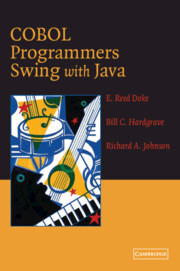Book contents
- Frontmatter
- Contents
- Preface
- Introduction
- Chapter 1 Why You Should Learn Java
- Chapter 2 An Introduction to Object-Oriented Programming
- Chapter 3 Java Structure
- Chapter 4 Defining Data
- Chapter 5 Computation
- Chapter 6 Decision Making
- Chapter 7 Loops
- Chapter 8 Arrays
- Chapter 9 Data Access
- Chapter 10 Graphical User Interfaces
- Chapter 11 Object-Oriented Development Issues
- Glossary
- Index
Introduction
Published online by Cambridge University Press: 26 August 2009
- Frontmatter
- Contents
- Preface
- Introduction
- Chapter 1 Why You Should Learn Java
- Chapter 2 An Introduction to Object-Oriented Programming
- Chapter 3 Java Structure
- Chapter 4 Defining Data
- Chapter 5 Computation
- Chapter 6 Decision Making
- Chapter 7 Loops
- Chapter 8 Arrays
- Chapter 9 Data Access
- Chapter 10 Graphical User Interfaces
- Chapter 11 Object-Oriented Development Issues
- Glossary
- Index
Summary
We organized the chapters in this book to be read in sequence. However, each chapter begins with a clear statement of what we assume you know before reading the chapter, so you can jump around a little bit, depending on your background and experience. You can use the book as a reference and jump in anywhere once you have the fundamentals.
Chapter 1 presents reasons why you should learn Java and describes the many similarities between COBOL and Java.
Chapter 2 explains what OO is, and what it is not. OO terms and concepts are described using several everyday examples.
Chapter 3 describes the overall structure and format of a Java program. Several small programs are developed to show you how to create objects and call methods.
Chapter 4 shows you how to define Java data items and use them in a program. Java data definition is somewhat different than COBOL and these differences are clearly explained and demonstrated in the program examples.
Chapter 5 introduces Java computation and, again, several small programs are written to illustrate the ideas and concepts present. You will see that some Java computation is nearly identical to COBOL.
Chapter 6 illustrates how to use the Java decision-making statements.
- Type
- Chapter
- Information
- COBOL Programmers Swing with Java , pp. 1 - 2Publisher: Cambridge University PressPrint publication year: 2004



